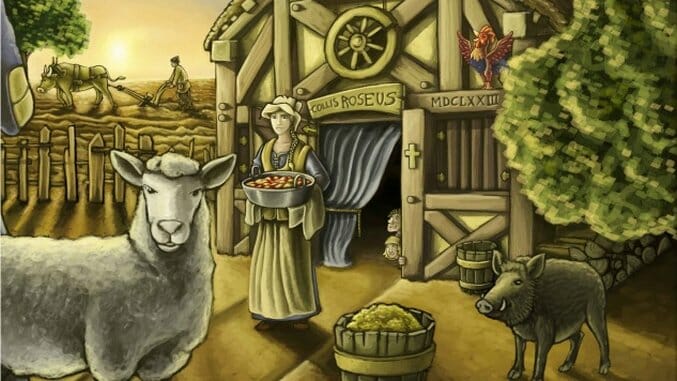Uwe Rosenberg’s Agricola Boardgame

The current surge in interest in better boardgames (German-style, Euro, whatever you want to call them) has led some of the biggest publishers to bring back titles that had fallen out of print or were just in need of a refresh. Two very highly-regarded games are now out in brand-new editions, Reiner Knizia’s Ra and Uwe Rosenberg’s Agricola. A review of the new edition of Ra ran earlier this month; now here’s a review of Agricola.
Agricola is an absolute behemoth in the Eurogame segment; after Settlers of Catan, there might not be another game that’s had as much influence on game development as Agricola has. Uwe Rosenberg’s unlikely hit—currently ranked 8th in Boardgamegeek’s all-time rankings, after a lengthy spell at #1—has inspired many other games that almost brag of their long playing times while ushering in a whole subgenre of games with rulebooks that resemble Russian literature. Yet of the many games that have followed in Agricola’s wake, none has quite captured the magic of the original, which manages to take an incredibly humble theme and a lengthy set of rules and make it somehow very fun.
This new edition of Agricola includes a suggested “junior” way to play that omits the cards that form the heart of the full game and give it many layers of complexity. This introductory game is ideal for younger players or folks who are new to the game as a whole and might be intimidated by learning the game and the mechanic of the cards at the same time. (Or who might play his first game with the full rule set against someone experienced and get absolutely trounced in the process. I’m looking at you, Tim.)
Agricola players are farmers who must feed their families first and foremost, and while doing that, try to build out their farmsteads by plowing fields, planting crops, and rearing animals. A player starts with two family members (oversized meeples in this new edition), and may gain up to three more over the course of the game. The game consists of fourteen rounds, and in one round each player may place each of his/her meeples somewhere on the board to undertake an action. A space occupied by one meeple is then off-limits to other players for the rest of that round, unless another player has a card that invalidates that rule, so there’s a strategy in when and where to place your farmers. The constant battle over the course of the game, however, is between acquiring resources for right now that let you feed your family—there are six harvests at which you must have at least two food tokens per adult family member plus one per baby (new in that round)—and building out your farm to produce more stuff as the game progresses.
-

-

-

-

-

-

-

-

-

-

-

-

-

-

-

-

-

-

-

-

-

-

-

-

-

-

-

-

-

-

-

-

-

-

-

-

-

-

-

-








































